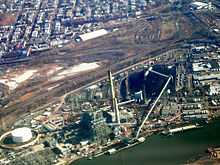Hudson Generating Station
| Hudson Generating Station | |
|---|---|
 Aerial view of the Hudson Generating Station with coal-delivery barges in the foreground | |
 | |
| Location | Jersey City, New Jersey |
| Coordinates | 40°44′50″N 74°04′21″W / 40.74722°N 74.07250°WCoordinates: 40°44′50″N 74°04′21″W / 40.74722°N 74.07250°W |
| Status | active |
| Commission date |
Unit 1 (gas): December, 1964 Unit 2 (coal): December, 1968 |
| Decommission date | Unit 3 (gas) |
| Owner(s) | PSE&G |
| Power station | |
| Primary fuel | low-sulphur bituminous coal from West Virginia, natural gas |
| Power generation | |
| Maximum capacity | 1,115 MWe |
Hudson Generating Station in Jersey City, New Jersey is a two-unit, 1,115-megawatt power plant, owned and operated by PSE&G (PSEG). Unit 1 produces electricity by burning natural gas. Unit 2 (nominal 660 MW) runs mainly on coal, but it can also use natural gas.[1] When running on solid fuel, Unit 2 burns only low sulfur coal to reduce the emissions of sulfur dioxide and utilizes an electrostatic precipitator to control particulate emissions.
Location
The Hudson Generating Station occupies a 250-acre (100 ha) site north of the intersection of Duffield and Van Keuren Avenues. Located on the east bank of the Hackensack River near the Riverbend, three miles (5 km) upstream from Newark Bay, it creates the perimeter of Croxton and the Marion Section, and borders Secaucus at Penhorn Creek.
History
The Hudson Generating Station was built on the site of the former Marion Generating Station, the first PSEG plant, which started operation in 1906. The Marion Station was the largest in the PSEG fleet until 1924. The bulk of the Marion station was retired in 1961, as construction on the Hudson Station began. Unit 1 was installed in 1964. Unit 2 was installed in 1968. Both units are now load following units.[2] Unit 3, a gas-burning turbine, was installed in ??? and shut down in ??? (some time after 1998[3]).
Current developments
On July 23, 2007, The Shaw Group was awarded a contract worth US $750 million to install mercury control, flue gas desulphurization, and selective catalytic reduction systems on Unit 2. These air emissions controls systems are scheduled for completion by the end of 2010.[4]
Fuel supply
Unit 2 typically burns a low-sulphur coal from West Virginia. In May 1996, a test on that coal indicated a 0.056 ppm (by weight) mercury content.[3] -According to the PSE&G annual report Coal for this plant comes from Indonesia -According to PSE&G's website: total plant capacity is 608Mwe
Water usage: There are no cooling towers at the PSE&G Hudson plant so Hackensack River water is utilized for the Plant's Rankine cycle condenser cooling. Since this plant is a very efficient fossil fuel plant, having a plant efficiency on the order of 41% -river water temperature rise is much much less than that of an equally sized Nuclear power plant
Emissions
| Pollutant | Units | Emission Standard | ||
|---|---|---|---|---|
| SO2 | lb/MMBTU | ≤ 0.15 | ??? | ??? |
| NOx | lb/MMBTU | ≤ 0.09 | ??? | ??? |
| Solid particulate | lb/MMBTU | ≤ 0.011 | ??? | ??? |
| PM10 | lb/MMBTU | ≤ 0.011 | ??? | ??? |
| SO3 | lb/hour | ≤ 1.1 | ??? | ??? |
| Fluoride | lb/MMBTU | ≤ 1.57×10−4 | ???×10−4 | ???×10−4 |
| Lead | lb/MMBTU | ≤ 2.6×10−5 | ???×10−5 | ???×10−5 |
| Mercury | lb/MMBTU | ≤ 1.05×10−5 | ???×10−5 | ???×10−5 |
Habitats and Environment
Ospreys
In 1997 PSE&G officials discovered failed attempts by ospreys to build nests on a transmission tower at the Hudson Generating Station. To encourage ospreys to roost along the Hackensack River, Public Service Electric and Gas Co. erected a nesting platform atop a utility pole at the Hudson Generating Station the following year. The platform was built by students from the Hudson Liberty Council's Boy Scouts of America and the Urban League of Hudson County's youth build program.[5] However, the first osprey chick to hatch in the New Jersey Meadowlands since the early 20th century took to the air only on July 13, 2007, from its nest located at PSEG's Hudson Generating Station.[6]
Conflicts and controversies
Despite major investment in improvements in the facility some activists still consider it a detriment to the community.[7]
References
- ↑ "Existing Electric Generating Units in the United States, 2006" (Excel). Energy Information Administration, U.S. Department of Energy. 2006. Retrieved 2008-07-14.
- ↑ The Hudson Generating Station
- ↑ 3.0 3.1 Haythornthwaite, S.; Ruhl, J.; Slye, R.; Butz, J. (1998). Assessing air pollution Control Options at the Hudson Station of Public Service Electric and Gas (PDF). Palo Alto, CA, and Newark, NJ: EPRI and PSEG. TR-110867
- ↑ "Shaw Awarded Engineering, Procurement and Construction Management Contract by PSEG Fossil for Air Emissions Controls Systems at the Hudson Generating Station". Business Wire. July 23, 2007. Retrieved 2008-06-17.
- ↑ Wild New Jersey - Ospreys on the Hackensack
- ↑ Hackensack Riverkeeper Press Release
- ↑ McCardle, John (July 8, 2011), "Jersey City Power Plant Cleans Up Emissions but Can't Escape Activists' Wrath", New York Times